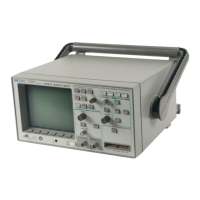Time base and Acquisition
The analyzer acquires data by sampling the voltage on each input channel
and comparing it to the threshold voltage to determine whether the input was
a logic high or logic low. The interval at which the input is sampled is called
the sample period.
Because there is a finite amount of acquisition memory in the HP 54620A/C,
the instrument is optimized to deliver the smallest sample period possible,
while still acquiring enough data to provide at least a full screen of waveform
at any Time/Div (or time base) setting. To achieve this goal, the analyzer
must vary the sample period as a function of the time base setting. Other
analyzer functions that depend on the sample period, such as duration
trigger, are therefore affected when the time base setting is changed.
Consider what would happen if the sample period were not varied with
respect to the time base setting. If the sample period remained constant at
2 ns, at 1 s/div, the waveform would occupy a little over 16 µs (for 8
Ksamples). Thus, it would not be visible on the screen, because 16 µs is only
a small fraction of a single division at this sweep speed. This would defeat the
goal of switching to a larger Time/Div value, which is to see data over a larger
span of time.
However, because acquisition mode, trigger functions, delayed sweep, and
measurement functions depend on the sample period, you must be aware of
the relationships to ensure that you achieve the desired measurement results.
Relationship Between Time base and Analyzer Functions
Figure 35
Ensuring Accurate Measurements
Time base and Acquisition
129

